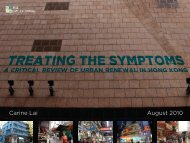Untitled - Civic Exchange
Untitled - Civic Exchange
Untitled - Civic Exchange
Create successful ePaper yourself
Turn your PDF publications into a flip-book with our unique Google optimized e-Paper software.
Chapter 7:<br />
The Dynamics of Decision-making in Hong Kong<br />
undermine the financially viability of any rail line in the area.<br />
Furthermore, in November 2001, the PD published a consultation paper showing concept plans for the<br />
future development of Aberdeen as a prime recreation and tourist area. 273 Anywhere else in the world, this<br />
kind of plan would only go ahead with assured transport support from an appropriate rail link. In private<br />
discussions with government planners, it is clear that a SIL would be highly desirable, but it is not within<br />
the remit of the PD to express this view in public as rail and road planning are the responsibility of the TB<br />
and the TD.<br />
The controversy over Route 7 illustrates a number of serious flaws in the transport decision-making system<br />
in Hong Kong:<br />
• Lack of critical analysis and debate and minimal research on alternative options - The TB<br />
conducted a road and rail comparison only after considerable public pressure. When it did so, it ran<br />
an existing transport model with little or no comprehensive analysis of each of the options. The TB<br />
also sought to obfuscate the argument by:<br />
(a) noting (correctly) that road and rail are complementary, when the issue is whether in the<br />
specific case of Pokfulam and Aberdeen, rail is the superior option, and<br />
(b) implying that road and rail are both possible when it is clear that competition from a road<br />
considerably lessens the ability of a rail line to be fully or largely self-financing;<br />
• Failure to consider whether the preferred solution is the most sustainable and cost-effective option<br />
- A subsidy of HK$4-5 billion to a rail operator might enable the construction of a SIL, although<br />
the TB proposed to spend much more (possibly HK$8-10 billion) on building Route 7;<br />
• Lack of integrated and cross-departmental planning - Coordination between the TB and the PD is<br />
basically non-existent, as is evident in discussions of the Aberdeen Focus Study; and<br />
• Lack of rigorous internal assessment of options - The CS and FS, as well as the Executive Council,<br />
appear to lack the capacity to pick up on and correct the biased nature of the policy assessment<br />
process. Implementation of the POAS will not help unless there is acknowledgement of the<br />
systematic problems in the decision-making process at the highest level of the executive.<br />
273 Planning Department (2001), The Focus Study on Aberdeen Harbour, Public Consultation I, Hong Kong:<br />
HKSAR Government.<br />
85

















